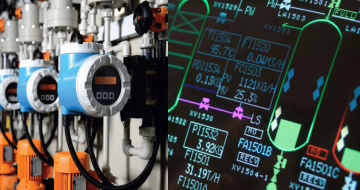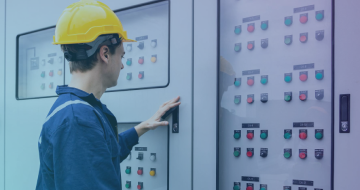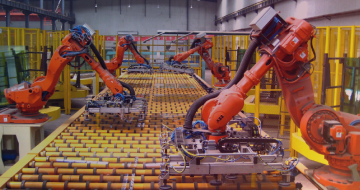IIRF Online > Business > Industry > Control Engineering > Process Control & Instrumentation 16 Hour Masterclass
Process Control & Instrumentation 16 Hour Masterclass by Udemy
Know & understand process control PID controllers control valves actuators positioners & instrumentation like a pro
Course Highlights
- Learn the essentials of process controls and PID controllers for a successful career in process industries
- Successfully draw the correct information from basic to advanced process control loops
- Master the intricate terminological details of process control (process variable, set point, error, offset, load disturbance...)
- Identify any process control loop and describe its main tasks and functionalities
- Describe the basic function and method of operation for the main control loop components (sensor, transmitter, controller, actuator, control valve...)
- Differentiate between feedback and feedforward control loops
- Explain the basic implementation process for each of the following types of control: Cascade, ratio, split range…
- Differentiate between On/Off, discrete, multi-step and continuous controllers
- Describe the basic mechanism, pros and cons of the following modes of control action: On/Off, Proportional (P), Integral (I), Derivative (D), PI, PID...
- Describe the general goal of PID controller tuning
- Apply the Ziegler Nicholls method to tune P, PI and PID controllers for optimum performance
- Understand control valves working principles for successful operation of your plant and piping systems
- Understand control valve construction details (bonnet, stem, disc, seat, packing, body, actuator, positioner…)
- Identify and know the principles of operation of common control valve actuators (diaphragm, piston, rack and pinion, scotch yoke)
- Dismantle and assemble various types of control valves and actuators using 3D and 2D models
- Understand how single acting and double acting pneumatic actuators work through graphics and 3D animations
- Know how to convert a single acting spring return actuator to a double acting actuator and vice versa
- Understand the concept of failure mode in control valves : Fail Open "FO", Fail Closed "FC", Fail As Is "FAI"
- Understand the concept of "Air-to-push-up" and Air-to-push-down"
- Understand the concept of "direct-acting" and "reverse-acting"
- Know how to convert a fail close actuator to a fail open actuator and vice versa
- Understand the concept of valve flow coefficient "Cv" and familiarize yourself with the various units
- Know how to determine flowrate and pressure drop through control valves for different valve lifts
- Know how to match the valve characteristics to the process
- Know how to construct the installation curve for a given control valve
- Understand the effect of selecting a control valve larger than necessary
- Understand the effect of differential pressure on the valve lift and actuator operation
- Differentiate between fast opening, linear and equal percentage valve characteristics
- Understand how valve positioners operate
- Know the different types of valve positioners (P/P, I/P, force balance, motion balance, digital…)
- Understand when a positioner should be fitted
- Understand the working principles of I/P converters and how they are used in control valves
- Understand the control of pressure in a pipe
- Understand the control of flow in a pipe
- Understand how self-acting pressure controls work and their applications
- Understand how self-acting temperature controls work and their applications
- Understand flow merging control
- Understand flow splitting control
- Understand centrifugal pump control systems (discharge throttling, variable speed drive, minimum flow…)
- Understand positive displacement pump control systems (recirculation pipe, variable speed drive, stroke adjustment…)
- Understand compressor control systems (capacity control, variable speed drive, anti-surge…)
- Understand heat exchanger control systems (direct control, bypass control, back pressure control…)
- Understand reactor temperature control systems
- Understand fired heater control systems
- Understand container and vessel control systems
- Understand electric motor control systems (ON / OFF actions)
- Know and understand the concept of Safety Instrumented Systems (SIS)
- Know and understand the concept of Alarm Systems and Interlocks
- Understand through extensive 3D animation the techniques and methods used in process industries to measure temperature, pressure, flow and level
- Put your knowledge to the test at the end of each section with a valuable technical quiz (420+ questions and solved problems)
- Get access to a set of valuable downloadable resources
Skills you will learn!
Curriculum
1 Topic
Masterclass introduction
11 Topics
Introduction to controls
Do we need to control at all ?
Control terminology
Elements of automatic control
Assessing Safety Stability & Accuracy
Summary of terminology
Elements of a temperature control system
Automatic process control
Components of an automatic control
Before proceeding to the next section
Section Quiz : Test Your Knowledge
21 Topics
Modes of control
On/Off control
Continuous control
Proportional control (P)
Proportional temperature control example
The concept of gain
Reverse vs direct acting control signal
Industrial Example - The FOXBORO 43AP Pneumatic Indicating Controller
Gain line offset - Proportional effect
Manual reset
Integral control (I): Auto reset action
Integral control (I): Overshoot and wind-up
Derivative control (D)
Summary of modes of control: P / PI / PD / PID
Time constant
Hunting
Practical Example: The effect of hunting on a steam system
Lag
Rangeability
Before proceeding to the next section
Section Quiz : Test Your Knowledge
14 Topics
Introduction
Control loops
Open loop controls
Closed loop controls
Feedback control
Feed-forward control
Single loop control
Multi-loop control
Cascade control
Ratio control
Split range control
Operations on control signals
Before proceeding to the next section
Section Quiz : Test Your Knowledge
4 Topics
Introduction
Process reactions
Before proceeding to the next section
Section Quiz : Test Your Knowledge
12 Topics
Introduction to choices and selection of process controls
Application
Self-acting controls
Pneumatic controls
Electric controls
Electropneumatic controls
What you should remember
What type of controls should be installed ?
What type of valves should be installed ?
Controllers
Before proceeding to the next section
Section Quiz : Test Your Knowledge
10 Topics
Valves
Actuators and sensors
Power and signal lines
Electrical wiring
Controllers
Setting up a controller: The Ziegler-Nicholls method
Bumpless transfer
Self-tuning controllers
Before proceeding to the next section
Section Quiz : Test Your Knowledge
6 Topics
Introduction
History
More on Fieldbus
Benefits of Fieldbus
Before proceeding to the next section
Section Quiz : Test Your Knowledge
11 Topics
Learning objectives
Introduction
Valve body
Valve bonnet
Trim
Plug and seat
Stem
Actuator
Packing
Before you proceed to the next section
Section Quiz : Test Your Knowledge
7 Topics
Control valves
Trim arrangement
Direction of action
Control valve 3D dismantling
Control valve 2D dismantling
Before you proceed to the next section
Section Quiz : Test Your Knowledge
12 Topics
Introduction
Two-port valves
Shut-off tightness
Balanced single seat
Slide valves - Spindle operated
Rotary valves
Options
Two-port valves summary
Three-port valves
Process examples of three-port valves
Before you proceed to the next section
Section Quiz : Test Your Knowledge
5 Topics
Introduction
Valve flow coefficient Cv
Use of flow coefficient Cv for piping and components
Before you proceed to the next section
Section Quiz : Test Your Knowledge
14 Topics
Flow characteristics
Fast opening
Linear
Equal percentage
Example: Determining flowrate for different valve lifts
Matching the valve characteristic to the process
Example: A water circulating heating system
Example: A boiler water level control system
Example: Constructing the installation curve
Example: Comparing linear and equal percentage
Example: Temperature control of a steam application
Example: The effect of selecting a control valve larger than necessary
Before you proceed to the next section
Section Quiz : Test Your Knowledge
9 Topics
Introduction
Pumps
Circulating system characteristics
Actual performance
Three-port valves
Two-port valves
Valve authority
Before proceeding to the next section
Section Quiz : Test Your Knowledge
20 Topics
Introduction
Saturated steam flow through a control valve
Critical pressure
Noise
Checking noise
Erosion
Sizing equations
The concept of "hunting"
The effect of "hunting" on a steam system
Sizing globe valves
Reminder
EXAMPLE: Sizing a control valve for a steam heating application
Sizing on an arbitrary pressure drop
The higher the pressure drop the better ?
EXAMPLE: Saturated steam for a critical pressure drop application
EXAMPLE: Saturated steam for a NON-critical pressure drop application
EXAMPLE: Finding the pressure drop across a control valve
EXAMPLE: Superheated steam application
Before proceeding to the next section
Section Quiz : Test Your Knowledge
20 Topics
Introduction
Piston actuators
Piston actuators (double acting) - 3D animation
Piston actuators (single acting) - Dismantling
Diaphragm actuators
Actuator valve combinations
Effect of differential pressure on the valve lift
What are valve positioners ?
Force balance positioners
Motion balance positioners
Example of positioners
Positioners: What you should remember
Positioners: When should a positioner be fitted
P/P positioners
I/P positioners
About I/P converters
Digital positioners
Summary: Selecting a pneumatic valve and actuator
Before you proceed to the next section
Section Quiz : Test Your Knowledge
12 Topics
Pneumatic actuators
Example 1 : Single acting / spring return actuators : Components & Operation
Example 2 : Single acting / spring return actuators : Components & Operation
Example 3 : Double acting actuators : Components & Operation
Example 4 : Double acting actuators : Components & Operation
From single acting to double acting actuator
From Fail Close (FC) to Fail Open (FO) - Scotch Yoke actuators
From Fail Close (FC) to Fail Open (FO) - Rack and Pinion Actuators
Rack and Pinion vs Scotch Yoke
Valve position indication
Before you proceed to the next section
Section Quiz : Test Your Knowledge
10 Topics
Controllers
Sensors
Filled system sensors
Resistance Temperature Detectors RTDs'
Thermistors
Thermocouples
Electrical communication signals
Digital addressing
Before proceeding to the next section
Section Quiz : Test Your Knowledge
12 Topics
Principles of operation
Vapor tension systems
Liquid self-acting temp. control valves
Required force for actuation
Bellows balanced valves
Double-seated control valves
Three-port control valve
Typical examples
Ancillaries
Environments and applications
Before proceeding to the next section
Section Quiz : Test Your Knowledge
9 Topics
Why reduce fluid pressure?
Direct acting control valves
Pilot operated control valves
Selection and installation
Summary of pressure reducing valves
Pressure maintaining valves
Pressure surplussing valves
Before proceeding to the next section
Section Quiz : Test Your Knowledge
16 Topics
Introduction to pressure control systems
Self-acting pressure reducing valves: Bellows type
Self-acting pressure reducing valves: Diaphragm type
Self-acting pressure reducing valves: Pilot-operated
Pneumatic pressure reduction
Electropneumatic pressure reduction
Electric pressure reduction
Series and parallel pressure reduction
Pressure reduction example: Steam desuperheater
Controlling pressure to control temperature
Differential pressure control
Surplussing control
Cascade pressure control: Example #1
Cascade pressure control: Example #2
Before proceeding to the next section
Section Quiz : Test Your Knowledge
11 Topics
Introduction
Why control temperature
Self-acting temperature control
Pilot-operated temperature control
Pneumatic temperature control
Electropneumatic temperature control
Electric temperature control
Parallel temperature control
High temperature fail safe control
Before proceeding to the next section
Section Quiz : Test Your Knowledge
7 Topics
Introduction
Methods of achieving level control
Non-adjustable On/Off control
Adjustable On/Off level control
Modulating level control
Before proceeding to the next section
Section Quiz : Test Your Knowledge
6 Topics
Introduction
Flow control system
Supply pressure variation
Using mass flowmeter differential pressure transmitter
Before proceeding to the next section
Section Quiz : Test Your Knowledge
8 Topics
Sensors
Controllers
Valves and actuators
Radio Frequency Interference (RFI)
Installation best practices to limit RFI
Electrical protection standards
Explosion protected electrical equipment
Section Quiz : Test Your Knowledge
30 Topics
Learning objectives
Why do we need to control ?
How to control ?
Pipe control: Example #1
Pipe control: Example #2
Pipe control: Example #3
Pipe control: Example #4
Flow control: Example #1
Flow control: Example #2
Pump control: Example #1
Pump control: Example #2
Pump control: Example #3
Pump control: Example #4
Pump control: Example #5
Pump control: Example #6
Pump control: Example #7
Compressor control: Example #1
Compressor control: Example #2
Compressor control: Example #3
Heat transfer equipment control: Example #1
Heat transfer equipment control: Example #2
Heat transfer equipment control: Example #3
Heat transfer equipment control: Example #4
Heat transfer equipment control: Example #5
Heat transfer equipment control: Example #6
Chemical reactor temperature control
Fired heater control: Example #1
Fired heater control: Example #2
Container and vessel control: Example #1
Container and vessel control: Example #2
26 Topics
Learning objectives
Safety strategies
Concepts of Safety Instrumented Systems (SIS)
SIS actions and types
SIS extent
SIS requirements
Anatomy of SIS
SIS element symbols
SIS primary elements sensors
SIS final elements
Switching valve actuator arrangements
Valve position validation
Merging switching and control valves
SIS logic
Showing safety instrumented functions on P&IDs
Discrete control
Alarm systems
Anatomy of alarm systems
Alarm requirements
Alarm system symbology
Concept of common alarms
Fire and Gas Detection Systems (FGS)
Electric motor controls
Electric motor controls 2/3
Electric motor 3/3
A typical example of an electric motor control system
1 Topic
Before you proceed to process instrumentation sections
5 Topics
Introduction
Local indicators
Bulb instruments for remote transmission
Thermocouples
Resistance Temperature Detectors (RTDs)
6 Topics
Hydrostatic manometers
Bourdon tube pressure gauges
Bellows pressure gauges
Strain pressure gauges
Piezoelectric pressure gauges
Capacitive pressure gauges
8 Topics
Orifice Nozzles & Venturi tubes
Pitot tubes
Annular probes
Rotameters
Vortex flowmeters
Ultrasound flowmeters
Electromagnetic flowmeters
Coriolis mass flowmeters
14 Topics
Introduction
Glass level gauges
Float level gauges
Float switches
Reed chain float sensors
Magnetic level gauges
Hydrostatic level gauges
Bubble tubes
Optoelectronic switches
Capillary systems
Ultarsonic sensors
Radars
Radiometric sensors
Bonus

Process Control & Instrumentation 16 Hour Masterclass




